Research on Employee Engagement and Business Success Report
VerifiedAdded on 2022/10/04
|20
|4353
|120
Report
AI Summary
This research report investigates the critical role of employee engagement in the workplace and its direct impact on organizational success. The report begins by defining employee engagement and highlighting its importance for business survival and profitability. It explores the key factors influencing employee engagement, including career advancement opportunities, training, and fair compensation, as well as the consequences of disengagement such as reduced productivity and increased turnover. The study adopts the self-determination theory to understand the motivational factors behind employee engagement, emphasizing the importance of autonomy, competence, and psychological relatedness. The report examines the relationship between employee engagement and various demographic factors, offering insights into how to tailor engagement strategies for different employee groups. It also includes a discussion on the importance of intrinsic motivation, flow capabilities, and the need for organizations to build a culture that fosters employee engagement to enhance financial performance. Finally, the research proposes practical solutions and recommendations for organizational leaders to improve workforce engagement and achieve business objectives.
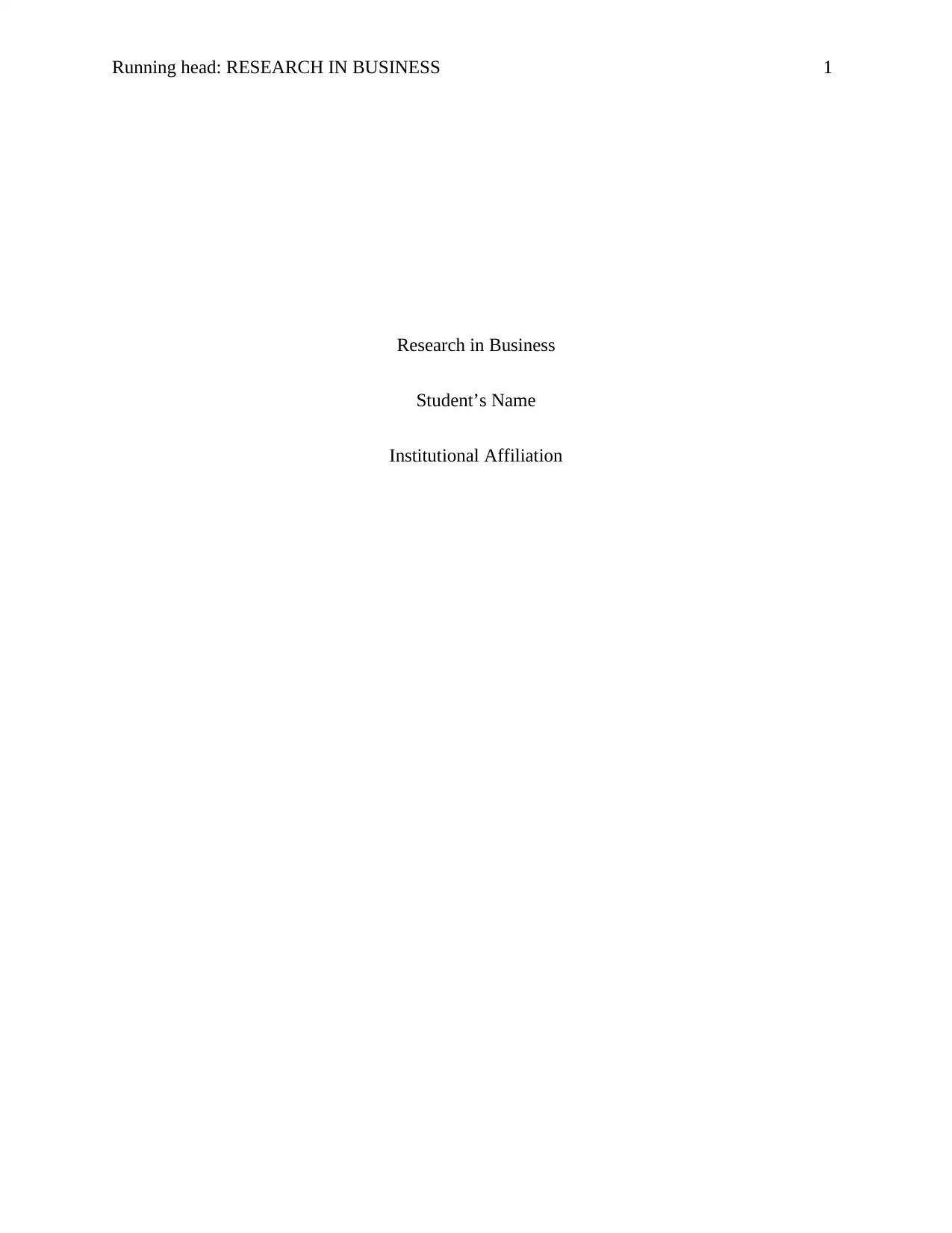
Running head: RESEARCH IN BUSINESS 1
Research in Business
Student’s Name
Institutional Affiliation
Research in Business
Student’s Name
Institutional Affiliation
Paraphrase This Document
Need a fresh take? Get an instant paraphrase of this document with our AI Paraphraser

RESEARCH IN BUSINESS 2
The Role Employee Engagement in the Workplace
Introduction
The survival as well as existence of the corporate industries solely depend upon
maximally the existing resources and the most vital asset towards maximizing profitability is the
organizations workforce. Indeed, employee engagement is a strategic strategy used to drive
improvements and encouraging organizational change (Men & Stacks, 2013). Recent research
has found that staffs who are effectively involved in their work and committed to their
corporations provide organizations with vital competitive advantages such lower employee
turnover, and higher productivity. As a result, it should be a surprise that all corporations ranging
from both small and large they ought to substantially invest in practices as well as policies which
foster engagement and commitment in the workforces (Osborne & Hammoud, 2017). Employee
commitment is the passion of employees, devotion and effective governance skills that have
support from the executive company management downwards to the employees. Human resource
managers are tasked with the responsibility to set the drive as well as statement of belief of their
organization and disseminate the positive morale amongst the employees of an organization.
Organization leaders have the primary task to engage their workforces. Leaders are
continuously supposed to show and make known that they value their employees. The only way
through which good employee engagement will happen is when employees feel strong and
positive regarding their relationship with their managers. However, if employees have a negative
attitude towards their managers or have a feeling that their manager has a negative attitude
toward them, it lowers their morale hence employee engagement may not happen. The
consequences of failure of employee engagement is reduced efficiency, high employee turnover
and increased organizational costs particularly on recruiting new employees. As a result, the
The Role Employee Engagement in the Workplace
Introduction
The survival as well as existence of the corporate industries solely depend upon
maximally the existing resources and the most vital asset towards maximizing profitability is the
organizations workforce. Indeed, employee engagement is a strategic strategy used to drive
improvements and encouraging organizational change (Men & Stacks, 2013). Recent research
has found that staffs who are effectively involved in their work and committed to their
corporations provide organizations with vital competitive advantages such lower employee
turnover, and higher productivity. As a result, it should be a surprise that all corporations ranging
from both small and large they ought to substantially invest in practices as well as policies which
foster engagement and commitment in the workforces (Osborne & Hammoud, 2017). Employee
commitment is the passion of employees, devotion and effective governance skills that have
support from the executive company management downwards to the employees. Human resource
managers are tasked with the responsibility to set the drive as well as statement of belief of their
organization and disseminate the positive morale amongst the employees of an organization.
Organization leaders have the primary task to engage their workforces. Leaders are
continuously supposed to show and make known that they value their employees. The only way
through which good employee engagement will happen is when employees feel strong and
positive regarding their relationship with their managers. However, if employees have a negative
attitude towards their managers or have a feeling that their manager has a negative attitude
toward them, it lowers their morale hence employee engagement may not happen. The
consequences of failure of employee engagement is reduced efficiency, high employee turnover
and increased organizational costs particularly on recruiting new employees. As a result, the
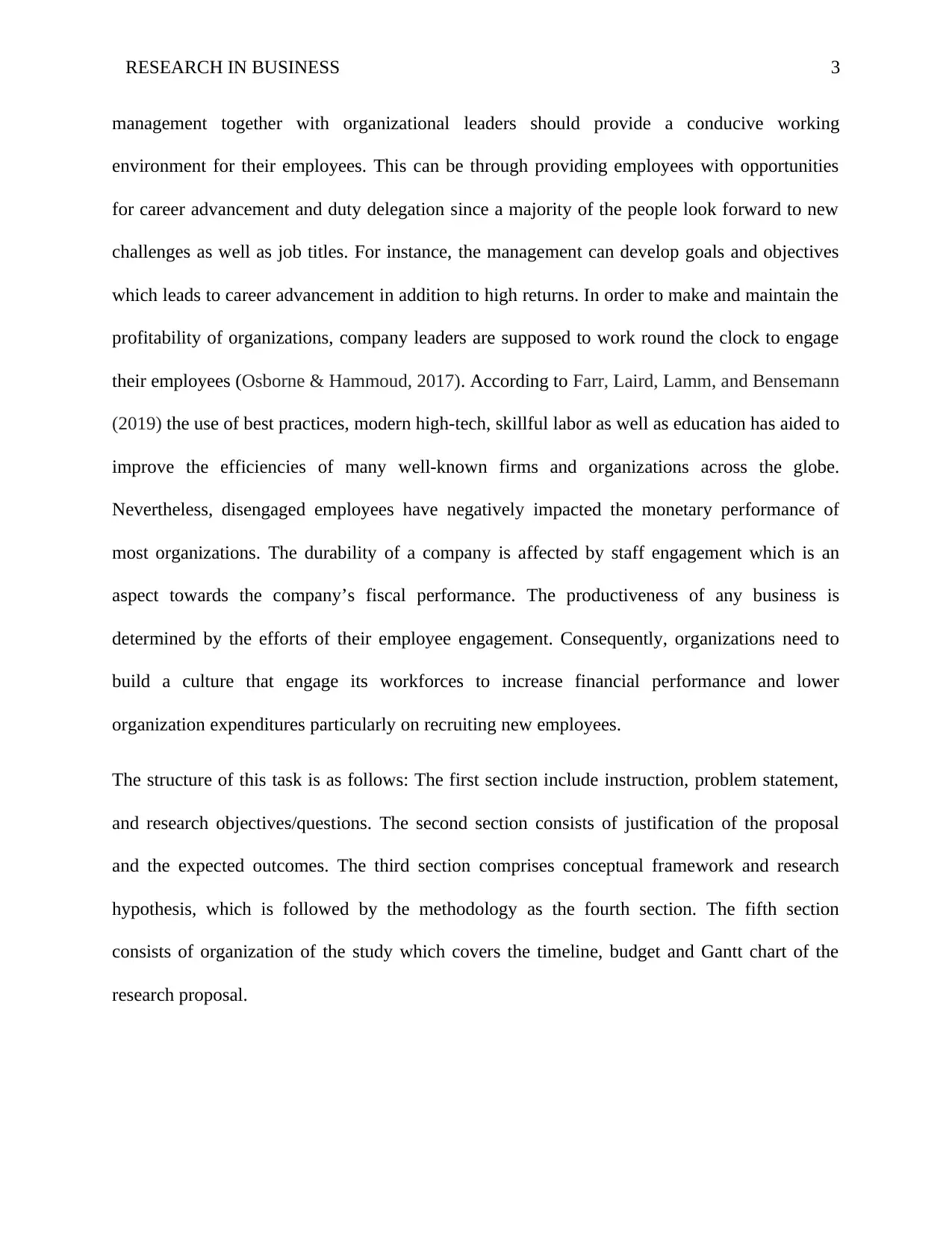
RESEARCH IN BUSINESS 3
management together with organizational leaders should provide a conducive working
environment for their employees. This can be through providing employees with opportunities
for career advancement and duty delegation since a majority of the people look forward to new
challenges as well as job titles. For instance, the management can develop goals and objectives
which leads to career advancement in addition to high returns. In order to make and maintain the
profitability of organizations, company leaders are supposed to work round the clock to engage
their employees (Osborne & Hammoud, 2017). According to Farr, Laird, Lamm, and Bensemann
(2019) the use of best practices, modern high-tech, skillful labor as well as education has aided to
improve the efficiencies of many well-known firms and organizations across the globe.
Nevertheless, disengaged employees have negatively impacted the monetary performance of
most organizations. The durability of a company is affected by staff engagement which is an
aspect towards the company’s fiscal performance. The productiveness of any business is
determined by the efforts of their employee engagement. Consequently, organizations need to
build a culture that engage its workforces to increase financial performance and lower
organization expenditures particularly on recruiting new employees.
The structure of this task is as follows: The first section include instruction, problem statement,
and research objectives/questions. The second section consists of justification of the proposal
and the expected outcomes. The third section comprises conceptual framework and research
hypothesis, which is followed by the methodology as the fourth section. The fifth section
consists of organization of the study which covers the timeline, budget and Gantt chart of the
research proposal.
management together with organizational leaders should provide a conducive working
environment for their employees. This can be through providing employees with opportunities
for career advancement and duty delegation since a majority of the people look forward to new
challenges as well as job titles. For instance, the management can develop goals and objectives
which leads to career advancement in addition to high returns. In order to make and maintain the
profitability of organizations, company leaders are supposed to work round the clock to engage
their employees (Osborne & Hammoud, 2017). According to Farr, Laird, Lamm, and Bensemann
(2019) the use of best practices, modern high-tech, skillful labor as well as education has aided to
improve the efficiencies of many well-known firms and organizations across the globe.
Nevertheless, disengaged employees have negatively impacted the monetary performance of
most organizations. The durability of a company is affected by staff engagement which is an
aspect towards the company’s fiscal performance. The productiveness of any business is
determined by the efforts of their employee engagement. Consequently, organizations need to
build a culture that engage its workforces to increase financial performance and lower
organization expenditures particularly on recruiting new employees.
The structure of this task is as follows: The first section include instruction, problem statement,
and research objectives/questions. The second section consists of justification of the proposal
and the expected outcomes. The third section comprises conceptual framework and research
hypothesis, which is followed by the methodology as the fourth section. The fifth section
consists of organization of the study which covers the timeline, budget and Gantt chart of the
research proposal.
⊘ This is a preview!⊘
Do you want full access?
Subscribe today to unlock all pages.

Trusted by 1+ million students worldwide

RESEARCH IN BUSINESS 4
Problem Statement
Employee engagement is defined as a condition whereby the workforces are completely
captivated in their work and are emotionally attached to their organization (Deci & Ryan, 2012).
Mowbray, Wilkinson, and Tse, (2015) argue that the most critical aspect that drives sustainable
competitive advantages such organizational value and longevity, return on investment (ROI) is
the workforce. Therefore, with the highly competitive business setting of the present world calls
for employees that are highly engage to take an organizational to the next level of productivity.
With regard to Hu and Jiang (2018) employees who are passionate and dedicated to their
organizations leads to increased productivity and higher profits and generally improved
organizational performance. Nonetheless, organizations are being faced by several issues which
are threatening better employee engagement among many of the stagnated and failing business.
Some of the threats to better employee engagement include lack of career advancement, absence
of continued training and lower wages in most workplaces. Indeed, due to lack of continued
training, career advancement and better wages makes the employee to become reluctant in their
service delivery and seeking for alternative place of work. Therefore, due to the absence of
motivational activities in the workplaces results in high employee turnover, reduced productivity
and increased organizational expenses that in the end leads to business closure. In light of this
statement, this paper will discuss the issues that are plunging employee engagement among
organizations with the objective of providing these business enterprises with practical solutions
on how to improve their engagement of employees.
Research Aims and Objective
In a research proposal research and aims are vital components that have to be placed into
consideration prior to commencing the research. The research aim as well as the objectives have
Problem Statement
Employee engagement is defined as a condition whereby the workforces are completely
captivated in their work and are emotionally attached to their organization (Deci & Ryan, 2012).
Mowbray, Wilkinson, and Tse, (2015) argue that the most critical aspect that drives sustainable
competitive advantages such organizational value and longevity, return on investment (ROI) is
the workforce. Therefore, with the highly competitive business setting of the present world calls
for employees that are highly engage to take an organizational to the next level of productivity.
With regard to Hu and Jiang (2018) employees who are passionate and dedicated to their
organizations leads to increased productivity and higher profits and generally improved
organizational performance. Nonetheless, organizations are being faced by several issues which
are threatening better employee engagement among many of the stagnated and failing business.
Some of the threats to better employee engagement include lack of career advancement, absence
of continued training and lower wages in most workplaces. Indeed, due to lack of continued
training, career advancement and better wages makes the employee to become reluctant in their
service delivery and seeking for alternative place of work. Therefore, due to the absence of
motivational activities in the workplaces results in high employee turnover, reduced productivity
and increased organizational expenses that in the end leads to business closure. In light of this
statement, this paper will discuss the issues that are plunging employee engagement among
organizations with the objective of providing these business enterprises with practical solutions
on how to improve their engagement of employees.
Research Aims and Objective
In a research proposal research and aims are vital components that have to be placed into
consideration prior to commencing the research. The research aim as well as the objectives have
Paraphrase This Document
Need a fresh take? Get an instant paraphrase of this document with our AI Paraphraser
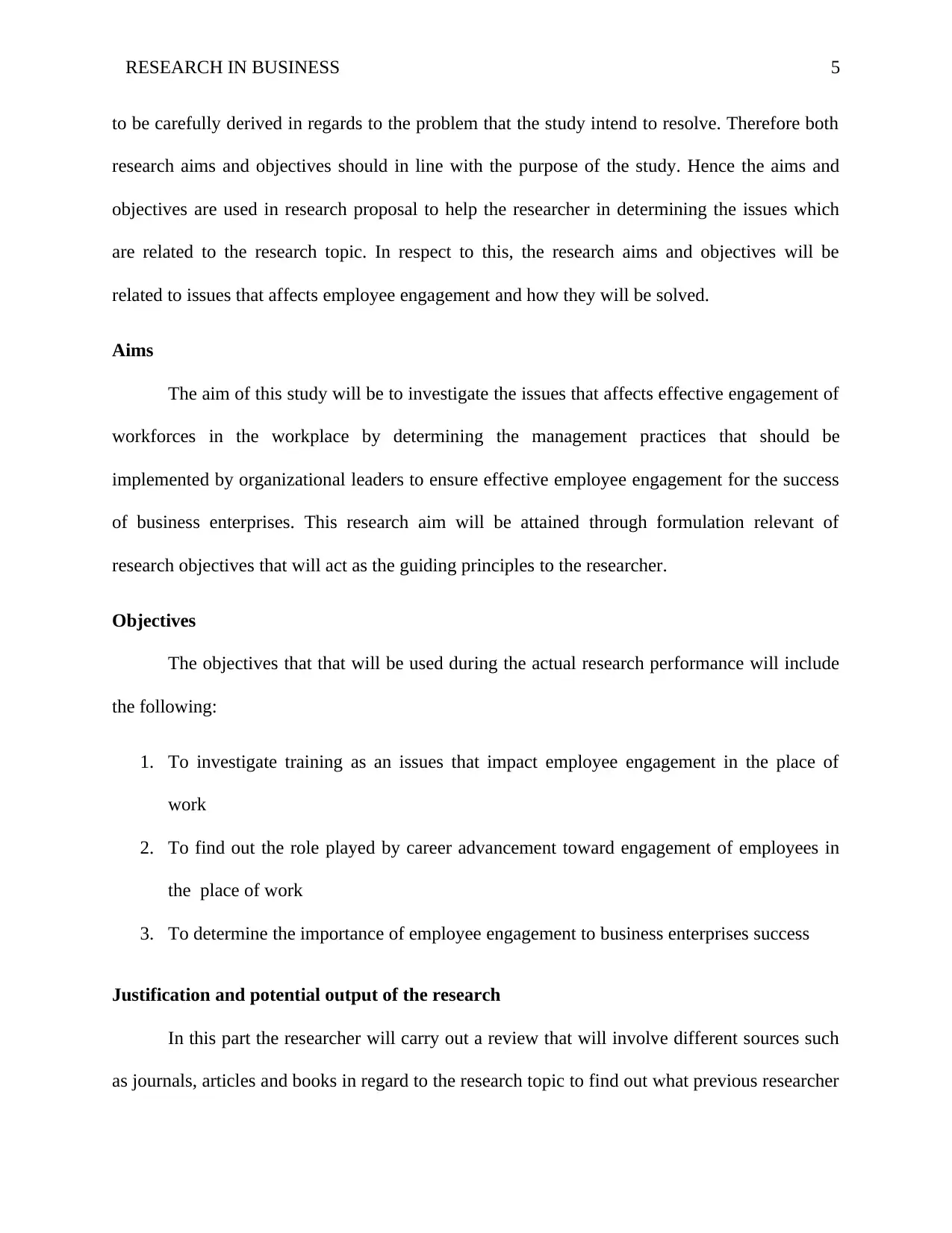
RESEARCH IN BUSINESS 5
to be carefully derived in regards to the problem that the study intend to resolve. Therefore both
research aims and objectives should in line with the purpose of the study. Hence the aims and
objectives are used in research proposal to help the researcher in determining the issues which
are related to the research topic. In respect to this, the research aims and objectives will be
related to issues that affects employee engagement and how they will be solved.
Aims
The aim of this study will be to investigate the issues that affects effective engagement of
workforces in the workplace by determining the management practices that should be
implemented by organizational leaders to ensure effective employee engagement for the success
of business enterprises. This research aim will be attained through formulation relevant of
research objectives that will act as the guiding principles to the researcher.
Objectives
The objectives that that will be used during the actual research performance will include
the following:
1. To investigate training as an issues that impact employee engagement in the place of
work
2. To find out the role played by career advancement toward engagement of employees in
the place of work
3. To determine the importance of employee engagement to business enterprises success
Justification and potential output of the research
In this part the researcher will carry out a review that will involve different sources such
as journals, articles and books in regard to the research topic to find out what previous researcher
to be carefully derived in regards to the problem that the study intend to resolve. Therefore both
research aims and objectives should in line with the purpose of the study. Hence the aims and
objectives are used in research proposal to help the researcher in determining the issues which
are related to the research topic. In respect to this, the research aims and objectives will be
related to issues that affects employee engagement and how they will be solved.
Aims
The aim of this study will be to investigate the issues that affects effective engagement of
workforces in the workplace by determining the management practices that should be
implemented by organizational leaders to ensure effective employee engagement for the success
of business enterprises. This research aim will be attained through formulation relevant of
research objectives that will act as the guiding principles to the researcher.
Objectives
The objectives that that will be used during the actual research performance will include
the following:
1. To investigate training as an issues that impact employee engagement in the place of
work
2. To find out the role played by career advancement toward engagement of employees in
the place of work
3. To determine the importance of employee engagement to business enterprises success
Justification and potential output of the research
In this part the researcher will carry out a review that will involve different sources such
as journals, articles and books in regard to the research topic to find out what previous researcher
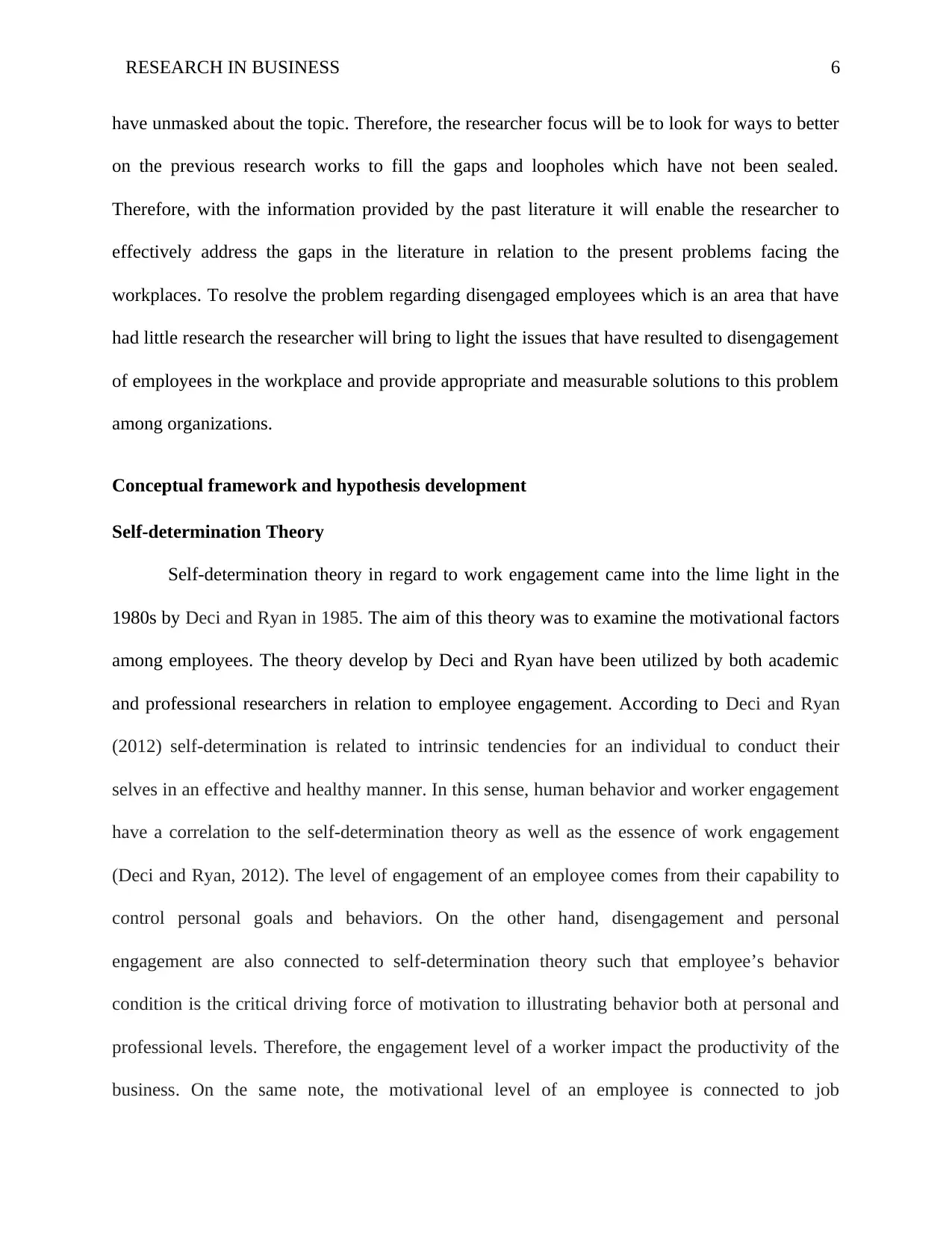
RESEARCH IN BUSINESS 6
have unmasked about the topic. Therefore, the researcher focus will be to look for ways to better
on the previous research works to fill the gaps and loopholes which have not been sealed.
Therefore, with the information provided by the past literature it will enable the researcher to
effectively address the gaps in the literature in relation to the present problems facing the
workplaces. To resolve the problem regarding disengaged employees which is an area that have
had little research the researcher will bring to light the issues that have resulted to disengagement
of employees in the workplace and provide appropriate and measurable solutions to this problem
among organizations.
Conceptual framework and hypothesis development
Self-determination Theory
Self-determination theory in regard to work engagement came into the lime light in the
1980s by Deci and Ryan in 1985. The aim of this theory was to examine the motivational factors
among employees. The theory develop by Deci and Ryan have been utilized by both academic
and professional researchers in relation to employee engagement. According to Deci and Ryan
(2012) self-determination is related to intrinsic tendencies for an individual to conduct their
selves in an effective and healthy manner. In this sense, human behavior and worker engagement
have a correlation to the self-determination theory as well as the essence of work engagement
(Deci and Ryan, 2012). The level of engagement of an employee comes from their capability to
control personal goals and behaviors. On the other hand, disengagement and personal
engagement are also connected to self-determination theory such that employee’s behavior
condition is the critical driving force of motivation to illustrating behavior both at personal and
professional levels. Therefore, the engagement level of a worker impact the productivity of the
business. On the same note, the motivational level of an employee is connected to job
have unmasked about the topic. Therefore, the researcher focus will be to look for ways to better
on the previous research works to fill the gaps and loopholes which have not been sealed.
Therefore, with the information provided by the past literature it will enable the researcher to
effectively address the gaps in the literature in relation to the present problems facing the
workplaces. To resolve the problem regarding disengaged employees which is an area that have
had little research the researcher will bring to light the issues that have resulted to disengagement
of employees in the workplace and provide appropriate and measurable solutions to this problem
among organizations.
Conceptual framework and hypothesis development
Self-determination Theory
Self-determination theory in regard to work engagement came into the lime light in the
1980s by Deci and Ryan in 1985. The aim of this theory was to examine the motivational factors
among employees. The theory develop by Deci and Ryan have been utilized by both academic
and professional researchers in relation to employee engagement. According to Deci and Ryan
(2012) self-determination is related to intrinsic tendencies for an individual to conduct their
selves in an effective and healthy manner. In this sense, human behavior and worker engagement
have a correlation to the self-determination theory as well as the essence of work engagement
(Deci and Ryan, 2012). The level of engagement of an employee comes from their capability to
control personal goals and behaviors. On the other hand, disengagement and personal
engagement are also connected to self-determination theory such that employee’s behavior
condition is the critical driving force of motivation to illustrating behavior both at personal and
professional levels. Therefore, the engagement level of a worker impact the productivity of the
business. On the same note, the motivational level of an employee is connected to job
⊘ This is a preview!⊘
Do you want full access?
Subscribe today to unlock all pages.

Trusted by 1+ million students worldwide
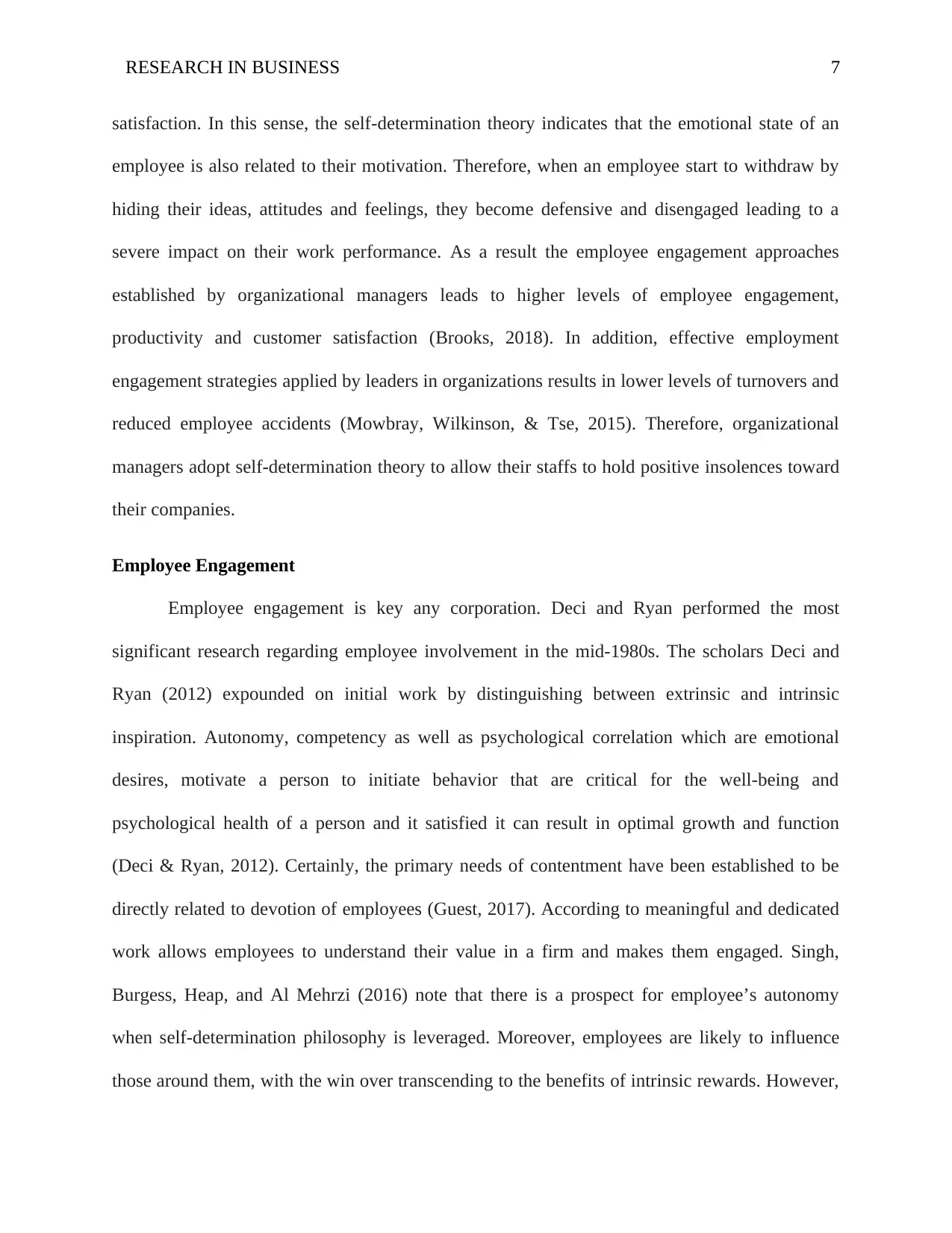
RESEARCH IN BUSINESS 7
satisfaction. In this sense, the self-determination theory indicates that the emotional state of an
employee is also related to their motivation. Therefore, when an employee start to withdraw by
hiding their ideas, attitudes and feelings, they become defensive and disengaged leading to a
severe impact on their work performance. As a result the employee engagement approaches
established by organizational managers leads to higher levels of employee engagement,
productivity and customer satisfaction (Brooks, 2018). In addition, effective employment
engagement strategies applied by leaders in organizations results in lower levels of turnovers and
reduced employee accidents (Mowbray, Wilkinson, & Tse, 2015). Therefore, organizational
managers adopt self-determination theory to allow their staffs to hold positive insolences toward
their companies.
Employee Engagement
Employee engagement is key any corporation. Deci and Ryan performed the most
significant research regarding employee involvement in the mid-1980s. The scholars Deci and
Ryan (2012) expounded on initial work by distinguishing between extrinsic and intrinsic
inspiration. Autonomy, competency as well as psychological correlation which are emotional
desires, motivate a person to initiate behavior that are critical for the well-being and
psychological health of a person and it satisfied it can result in optimal growth and function
(Deci & Ryan, 2012). Certainly, the primary needs of contentment have been established to be
directly related to devotion of employees (Guest, 2017). According to meaningful and dedicated
work allows employees to understand their value in a firm and makes them engaged. Singh,
Burgess, Heap, and Al Mehrzi (2016) note that there is a prospect for employee’s autonomy
when self-determination philosophy is leveraged. Moreover, employees are likely to influence
those around them, with the win over transcending to the benefits of intrinsic rewards. However,
satisfaction. In this sense, the self-determination theory indicates that the emotional state of an
employee is also related to their motivation. Therefore, when an employee start to withdraw by
hiding their ideas, attitudes and feelings, they become defensive and disengaged leading to a
severe impact on their work performance. As a result the employee engagement approaches
established by organizational managers leads to higher levels of employee engagement,
productivity and customer satisfaction (Brooks, 2018). In addition, effective employment
engagement strategies applied by leaders in organizations results in lower levels of turnovers and
reduced employee accidents (Mowbray, Wilkinson, & Tse, 2015). Therefore, organizational
managers adopt self-determination theory to allow their staffs to hold positive insolences toward
their companies.
Employee Engagement
Employee engagement is key any corporation. Deci and Ryan performed the most
significant research regarding employee involvement in the mid-1980s. The scholars Deci and
Ryan (2012) expounded on initial work by distinguishing between extrinsic and intrinsic
inspiration. Autonomy, competency as well as psychological correlation which are emotional
desires, motivate a person to initiate behavior that are critical for the well-being and
psychological health of a person and it satisfied it can result in optimal growth and function
(Deci & Ryan, 2012). Certainly, the primary needs of contentment have been established to be
directly related to devotion of employees (Guest, 2017). According to meaningful and dedicated
work allows employees to understand their value in a firm and makes them engaged. Singh,
Burgess, Heap, and Al Mehrzi (2016) note that there is a prospect for employee’s autonomy
when self-determination philosophy is leveraged. Moreover, employees are likely to influence
those around them, with the win over transcending to the benefits of intrinsic rewards. However,
Paraphrase This Document
Need a fresh take? Get an instant paraphrase of this document with our AI Paraphraser
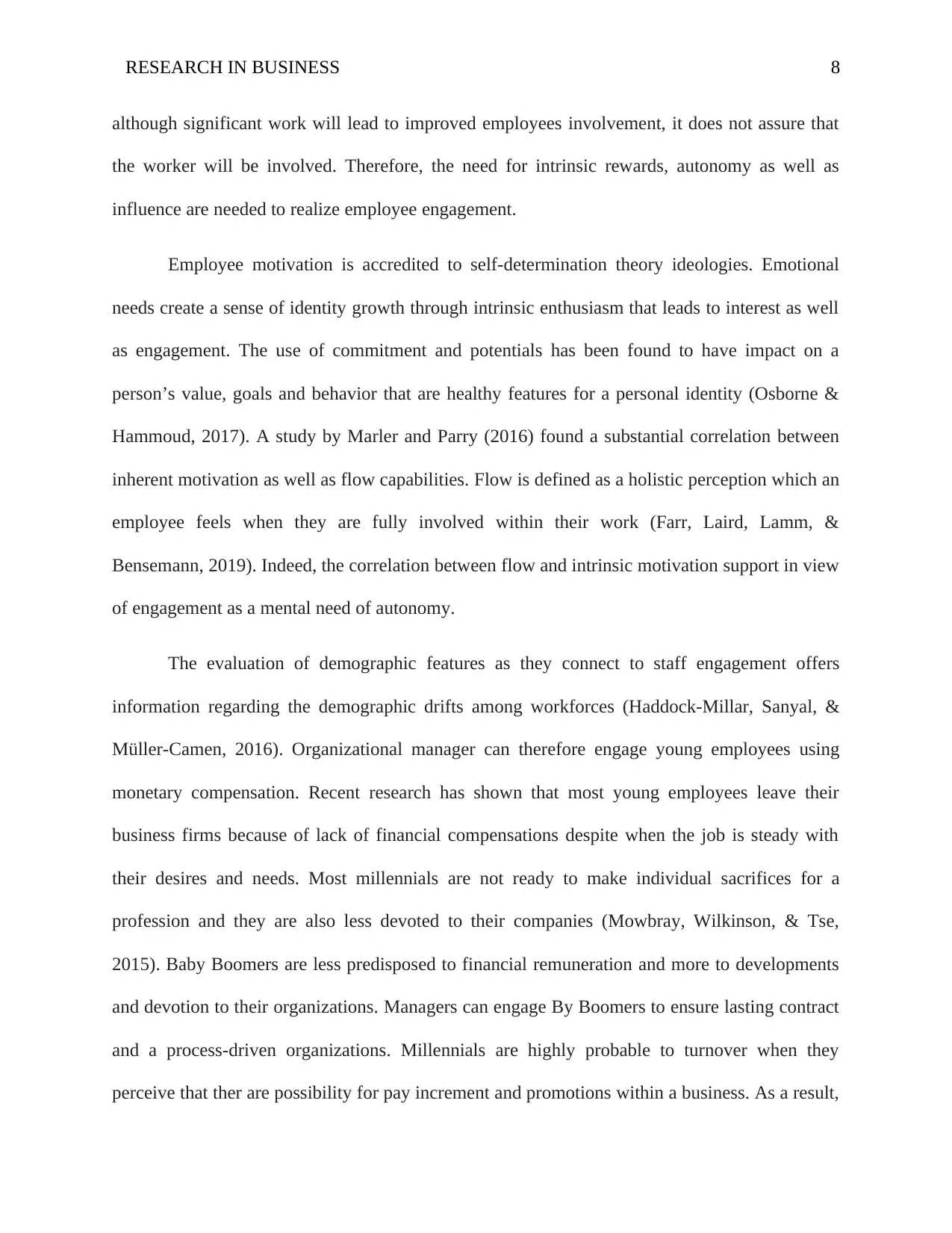
RESEARCH IN BUSINESS 8
although significant work will lead to improved employees involvement, it does not assure that
the worker will be involved. Therefore, the need for intrinsic rewards, autonomy as well as
influence are needed to realize employee engagement.
Employee motivation is accredited to self-determination theory ideologies. Emotional
needs create a sense of identity growth through intrinsic enthusiasm that leads to interest as well
as engagement. The use of commitment and potentials has been found to have impact on a
person’s value, goals and behavior that are healthy features for a personal identity (Osborne &
Hammoud, 2017). A study by Marler and Parry (2016) found a substantial correlation between
inherent motivation as well as flow capabilities. Flow is defined as a holistic perception which an
employee feels when they are fully involved within their work (Farr, Laird, Lamm, &
Bensemann, 2019). Indeed, the correlation between flow and intrinsic motivation support in view
of engagement as a mental need of autonomy.
The evaluation of demographic features as they connect to staff engagement offers
information regarding the demographic drifts among workforces (Haddock-Millar, Sanyal, &
Müller-Camen, 2016). Organizational manager can therefore engage young employees using
monetary compensation. Recent research has shown that most young employees leave their
business firms because of lack of financial compensations despite when the job is steady with
their desires and needs. Most millennials are not ready to make individual sacrifices for a
profession and they are also less devoted to their companies (Mowbray, Wilkinson, & Tse,
2015). Baby Boomers are less predisposed to financial remuneration and more to developments
and devotion to their organizations. Managers can engage By Boomers to ensure lasting contract
and a process-driven organizations. Millennials are highly probable to turnover when they
perceive that ther are possibility for pay increment and promotions within a business. As a result,
although significant work will lead to improved employees involvement, it does not assure that
the worker will be involved. Therefore, the need for intrinsic rewards, autonomy as well as
influence are needed to realize employee engagement.
Employee motivation is accredited to self-determination theory ideologies. Emotional
needs create a sense of identity growth through intrinsic enthusiasm that leads to interest as well
as engagement. The use of commitment and potentials has been found to have impact on a
person’s value, goals and behavior that are healthy features for a personal identity (Osborne &
Hammoud, 2017). A study by Marler and Parry (2016) found a substantial correlation between
inherent motivation as well as flow capabilities. Flow is defined as a holistic perception which an
employee feels when they are fully involved within their work (Farr, Laird, Lamm, &
Bensemann, 2019). Indeed, the correlation between flow and intrinsic motivation support in view
of engagement as a mental need of autonomy.
The evaluation of demographic features as they connect to staff engagement offers
information regarding the demographic drifts among workforces (Haddock-Millar, Sanyal, &
Müller-Camen, 2016). Organizational manager can therefore engage young employees using
monetary compensation. Recent research has shown that most young employees leave their
business firms because of lack of financial compensations despite when the job is steady with
their desires and needs. Most millennials are not ready to make individual sacrifices for a
profession and they are also less devoted to their companies (Mowbray, Wilkinson, & Tse,
2015). Baby Boomers are less predisposed to financial remuneration and more to developments
and devotion to their organizations. Managers can engage By Boomers to ensure lasting contract
and a process-driven organizations. Millennials are highly probable to turnover when they
perceive that ther are possibility for pay increment and promotions within a business. As a result,
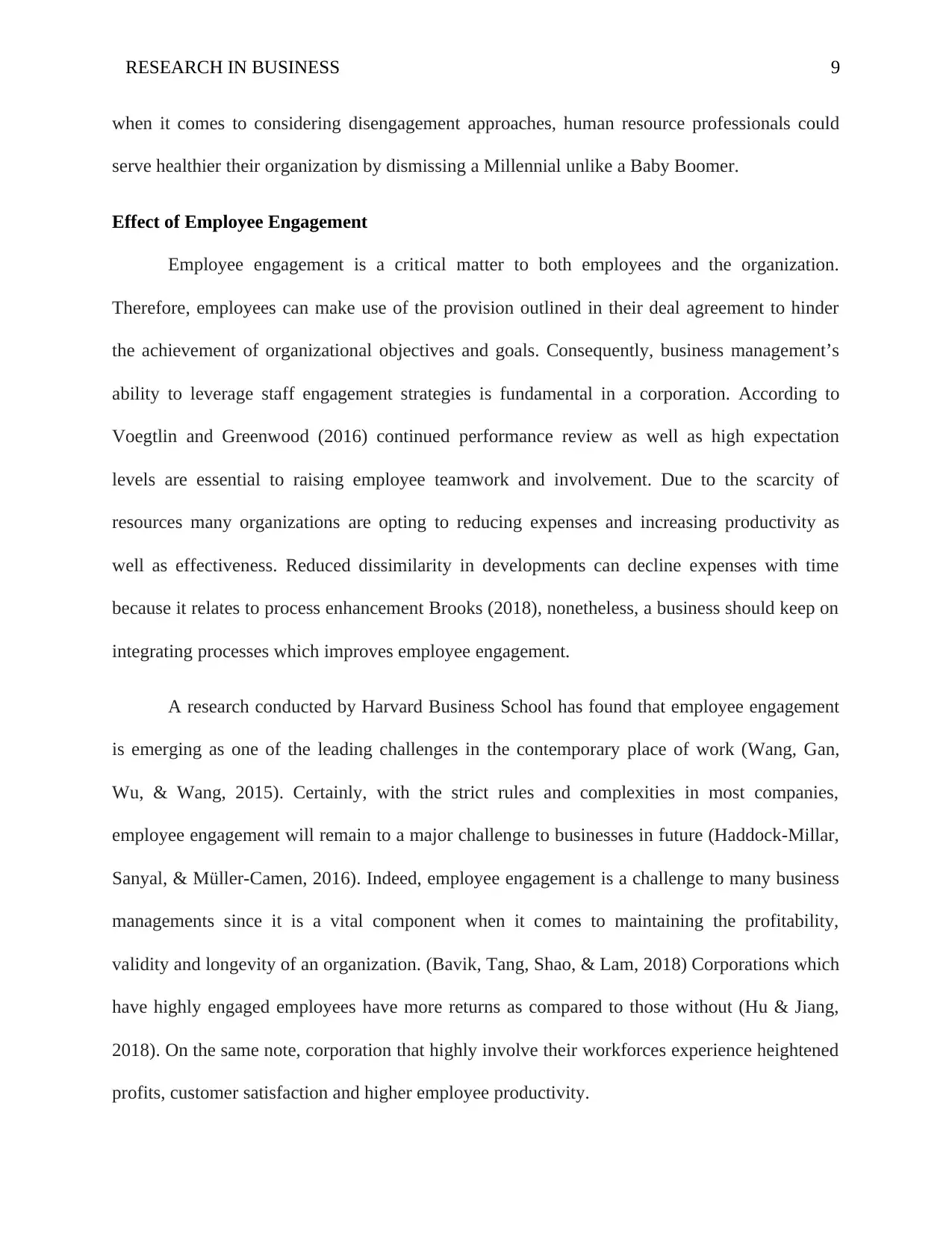
RESEARCH IN BUSINESS 9
when it comes to considering disengagement approaches, human resource professionals could
serve healthier their organization by dismissing a Millennial unlike a Baby Boomer.
Effect of Employee Engagement
Employee engagement is a critical matter to both employees and the organization.
Therefore, employees can make use of the provision outlined in their deal agreement to hinder
the achievement of organizational objectives and goals. Consequently, business management’s
ability to leverage staff engagement strategies is fundamental in a corporation. According to
Voegtlin and Greenwood (2016) continued performance review as well as high expectation
levels are essential to raising employee teamwork and involvement. Due to the scarcity of
resources many organizations are opting to reducing expenses and increasing productivity as
well as effectiveness. Reduced dissimilarity in developments can decline expenses with time
because it relates to process enhancement Brooks (2018), nonetheless, a business should keep on
integrating processes which improves employee engagement.
A research conducted by Harvard Business School has found that employee engagement
is emerging as one of the leading challenges in the contemporary place of work (Wang, Gan,
Wu, & Wang, 2015). Certainly, with the strict rules and complexities in most companies,
employee engagement will remain to a major challenge to businesses in future (Haddock-Millar,
Sanyal, & Müller-Camen, 2016). Indeed, employee engagement is a challenge to many business
managements since it is a vital component when it comes to maintaining the profitability,
validity and longevity of an organization. (Bavik, Tang, Shao, & Lam, 2018) Corporations which
have highly engaged employees have more returns as compared to those without (Hu & Jiang,
2018). On the same note, corporation that highly involve their workforces experience heightened
profits, customer satisfaction and higher employee productivity.
when it comes to considering disengagement approaches, human resource professionals could
serve healthier their organization by dismissing a Millennial unlike a Baby Boomer.
Effect of Employee Engagement
Employee engagement is a critical matter to both employees and the organization.
Therefore, employees can make use of the provision outlined in their deal agreement to hinder
the achievement of organizational objectives and goals. Consequently, business management’s
ability to leverage staff engagement strategies is fundamental in a corporation. According to
Voegtlin and Greenwood (2016) continued performance review as well as high expectation
levels are essential to raising employee teamwork and involvement. Due to the scarcity of
resources many organizations are opting to reducing expenses and increasing productivity as
well as effectiveness. Reduced dissimilarity in developments can decline expenses with time
because it relates to process enhancement Brooks (2018), nonetheless, a business should keep on
integrating processes which improves employee engagement.
A research conducted by Harvard Business School has found that employee engagement
is emerging as one of the leading challenges in the contemporary place of work (Wang, Gan,
Wu, & Wang, 2015). Certainly, with the strict rules and complexities in most companies,
employee engagement will remain to a major challenge to businesses in future (Haddock-Millar,
Sanyal, & Müller-Camen, 2016). Indeed, employee engagement is a challenge to many business
managements since it is a vital component when it comes to maintaining the profitability,
validity and longevity of an organization. (Bavik, Tang, Shao, & Lam, 2018) Corporations which
have highly engaged employees have more returns as compared to those without (Hu & Jiang,
2018). On the same note, corporation that highly involve their workforces experience heightened
profits, customer satisfaction and higher employee productivity.
⊘ This is a preview!⊘
Do you want full access?
Subscribe today to unlock all pages.

Trusted by 1+ million students worldwide
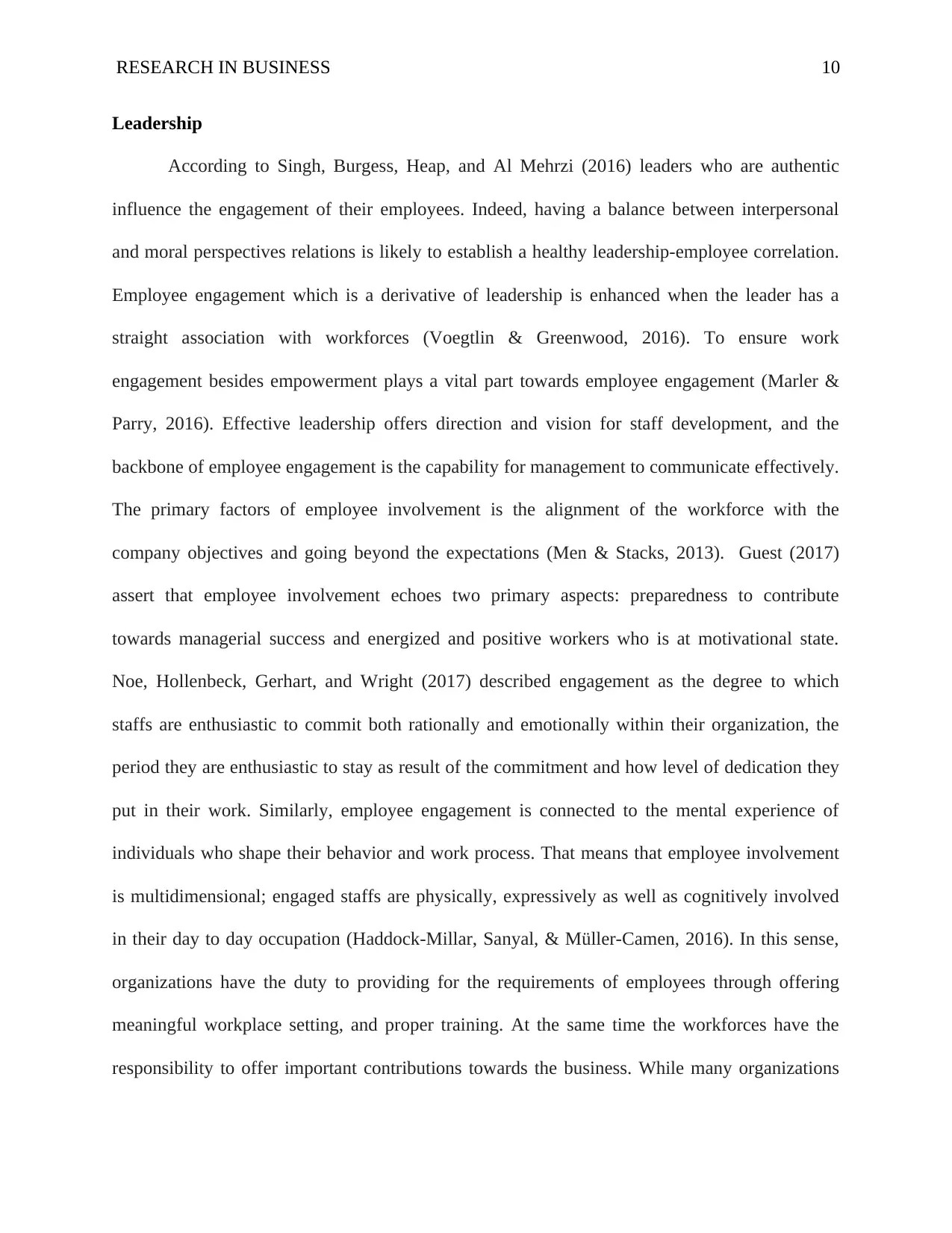
RESEARCH IN BUSINESS 10
Leadership
According to Singh, Burgess, Heap, and Al Mehrzi (2016) leaders who are authentic
influence the engagement of their employees. Indeed, having a balance between interpersonal
and moral perspectives relations is likely to establish a healthy leadership-employee correlation.
Employee engagement which is a derivative of leadership is enhanced when the leader has a
straight association with workforces (Voegtlin & Greenwood, 2016). To ensure work
engagement besides empowerment plays a vital part towards employee engagement (Marler &
Parry, 2016). Effective leadership offers direction and vision for staff development, and the
backbone of employee engagement is the capability for management to communicate effectively.
The primary factors of employee involvement is the alignment of the workforce with the
company objectives and going beyond the expectations (Men & Stacks, 2013). Guest (2017)
assert that employee involvement echoes two primary aspects: preparedness to contribute
towards managerial success and energized and positive workers who is at motivational state.
Noe, Hollenbeck, Gerhart, and Wright (2017) described engagement as the degree to which
staffs are enthusiastic to commit both rationally and emotionally within their organization, the
period they are enthusiastic to stay as result of the commitment and how level of dedication they
put in their work. Similarly, employee engagement is connected to the mental experience of
individuals who shape their behavior and work process. That means that employee involvement
is multidimensional; engaged staffs are physically, expressively as well as cognitively involved
in their day to day occupation (Haddock-Millar, Sanyal, & Müller-Camen, 2016). In this sense,
organizations have the duty to providing for the requirements of employees through offering
meaningful workplace setting, and proper training. At the same time the workforces have the
responsibility to offer important contributions towards the business. While many organizations
Leadership
According to Singh, Burgess, Heap, and Al Mehrzi (2016) leaders who are authentic
influence the engagement of their employees. Indeed, having a balance between interpersonal
and moral perspectives relations is likely to establish a healthy leadership-employee correlation.
Employee engagement which is a derivative of leadership is enhanced when the leader has a
straight association with workforces (Voegtlin & Greenwood, 2016). To ensure work
engagement besides empowerment plays a vital part towards employee engagement (Marler &
Parry, 2016). Effective leadership offers direction and vision for staff development, and the
backbone of employee engagement is the capability for management to communicate effectively.
The primary factors of employee involvement is the alignment of the workforce with the
company objectives and going beyond the expectations (Men & Stacks, 2013). Guest (2017)
assert that employee involvement echoes two primary aspects: preparedness to contribute
towards managerial success and energized and positive workers who is at motivational state.
Noe, Hollenbeck, Gerhart, and Wright (2017) described engagement as the degree to which
staffs are enthusiastic to commit both rationally and emotionally within their organization, the
period they are enthusiastic to stay as result of the commitment and how level of dedication they
put in their work. Similarly, employee engagement is connected to the mental experience of
individuals who shape their behavior and work process. That means that employee involvement
is multidimensional; engaged staffs are physically, expressively as well as cognitively involved
in their day to day occupation (Haddock-Millar, Sanyal, & Müller-Camen, 2016). In this sense,
organizations have the duty to providing for the requirements of employees through offering
meaningful workplace setting, and proper training. At the same time the workforces have the
responsibility to offer important contributions towards the business. While many organizations
Paraphrase This Document
Need a fresh take? Get an instant paraphrase of this document with our AI Paraphraser
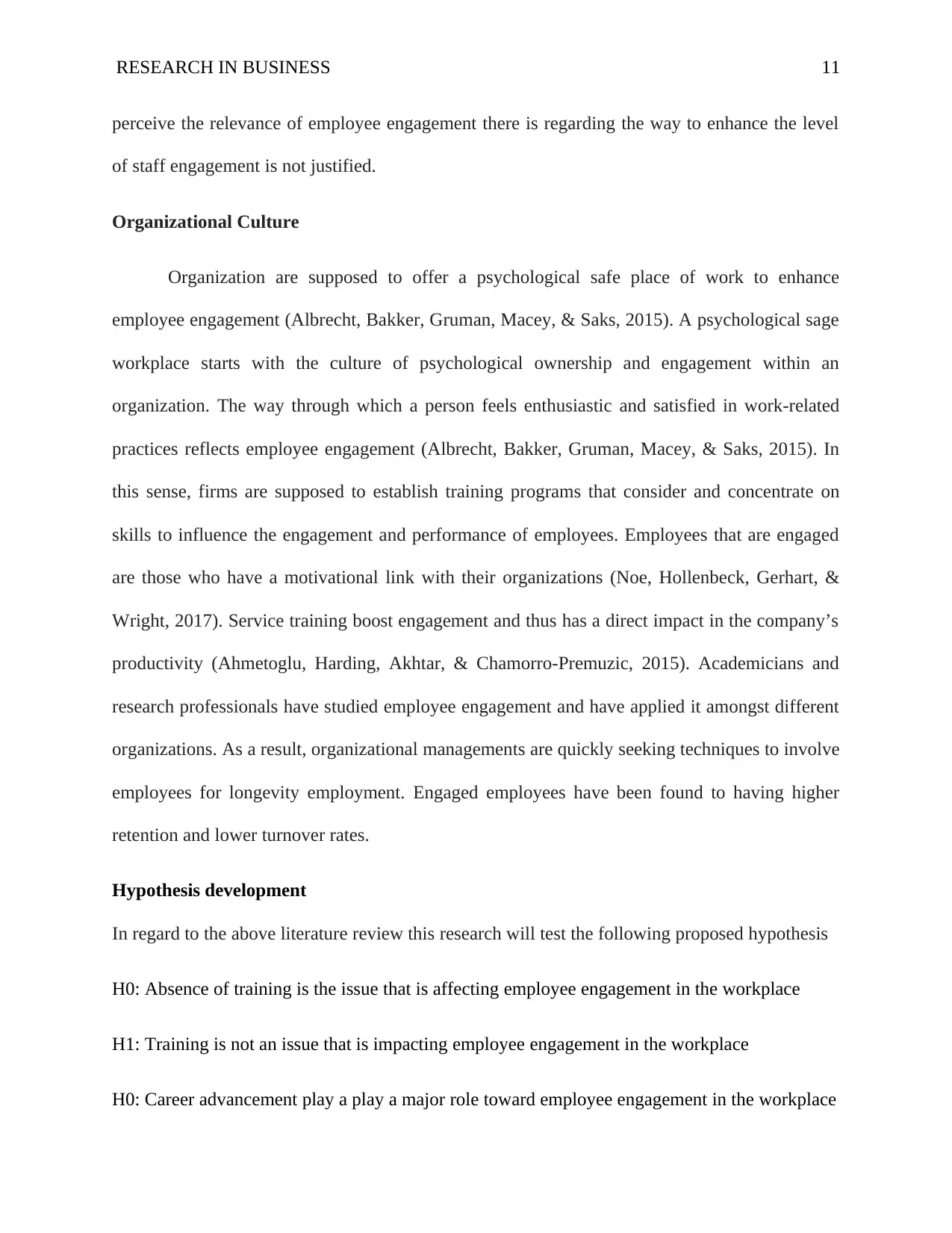
RESEARCH IN BUSINESS 11
perceive the relevance of employee engagement there is regarding the way to enhance the level
of staff engagement is not justified.
Organizational Culture
Organization are supposed to offer a psychological safe place of work to enhance
employee engagement (Albrecht, Bakker, Gruman, Macey, & Saks, 2015). A psychological sage
workplace starts with the culture of psychological ownership and engagement within an
organization. The way through which a person feels enthusiastic and satisfied in work-related
practices reflects employee engagement (Albrecht, Bakker, Gruman, Macey, & Saks, 2015). In
this sense, firms are supposed to establish training programs that consider and concentrate on
skills to influence the engagement and performance of employees. Employees that are engaged
are those who have a motivational link with their organizations (Noe, Hollenbeck, Gerhart, &
Wright, 2017). Service training boost engagement and thus has a direct impact in the company’s
productivity (Ahmetoglu, Harding, Akhtar, & Chamorro-Premuzic, 2015). Academicians and
research professionals have studied employee engagement and have applied it amongst different
organizations. As a result, organizational managements are quickly seeking techniques to involve
employees for longevity employment. Engaged employees have been found to having higher
retention and lower turnover rates.
Hypothesis development
In regard to the above literature review this research will test the following proposed hypothesis
H0: Absence of training is the issue that is affecting employee engagement in the workplace
H1: Training is not an issue that is impacting employee engagement in the workplace
H0: Career advancement play a play a major role toward employee engagement in the workplace
perceive the relevance of employee engagement there is regarding the way to enhance the level
of staff engagement is not justified.
Organizational Culture
Organization are supposed to offer a psychological safe place of work to enhance
employee engagement (Albrecht, Bakker, Gruman, Macey, & Saks, 2015). A psychological sage
workplace starts with the culture of psychological ownership and engagement within an
organization. The way through which a person feels enthusiastic and satisfied in work-related
practices reflects employee engagement (Albrecht, Bakker, Gruman, Macey, & Saks, 2015). In
this sense, firms are supposed to establish training programs that consider and concentrate on
skills to influence the engagement and performance of employees. Employees that are engaged
are those who have a motivational link with their organizations (Noe, Hollenbeck, Gerhart, &
Wright, 2017). Service training boost engagement and thus has a direct impact in the company’s
productivity (Ahmetoglu, Harding, Akhtar, & Chamorro-Premuzic, 2015). Academicians and
research professionals have studied employee engagement and have applied it amongst different
organizations. As a result, organizational managements are quickly seeking techniques to involve
employees for longevity employment. Engaged employees have been found to having higher
retention and lower turnover rates.
Hypothesis development
In regard to the above literature review this research will test the following proposed hypothesis
H0: Absence of training is the issue that is affecting employee engagement in the workplace
H1: Training is not an issue that is impacting employee engagement in the workplace
H0: Career advancement play a play a major role toward employee engagement in the workplace
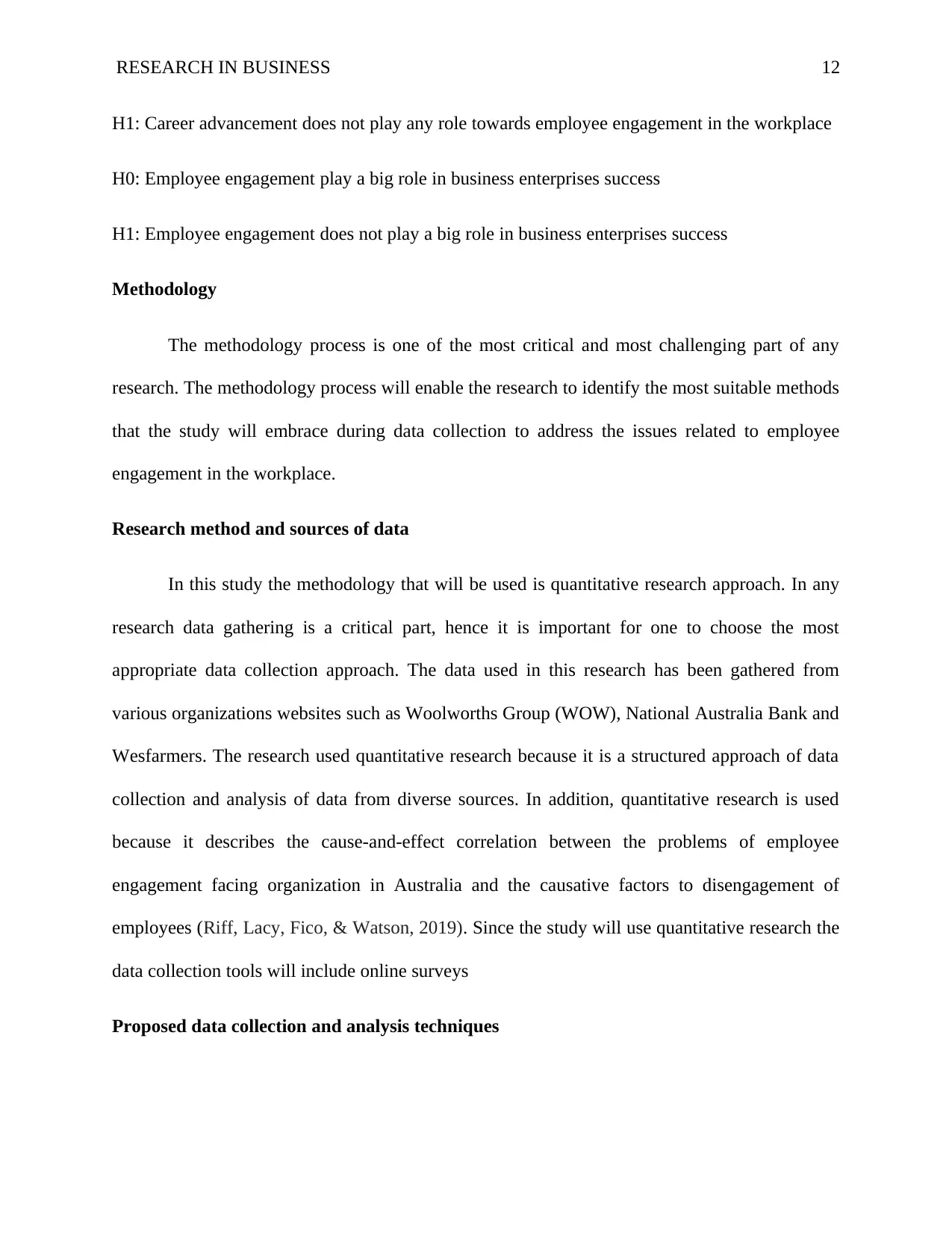
RESEARCH IN BUSINESS 12
H1: Career advancement does not play any role towards employee engagement in the workplace
H0: Employee engagement play a big role in business enterprises success
H1: Employee engagement does not play a big role in business enterprises success
Methodology
The methodology process is one of the most critical and most challenging part of any
research. The methodology process will enable the research to identify the most suitable methods
that the study will embrace during data collection to address the issues related to employee
engagement in the workplace.
Research method and sources of data
In this study the methodology that will be used is quantitative research approach. In any
research data gathering is a critical part, hence it is important for one to choose the most
appropriate data collection approach. The data used in this research has been gathered from
various organizations websites such as Woolworths Group (WOW), National Australia Bank and
Wesfarmers. The research used quantitative research because it is a structured approach of data
collection and analysis of data from diverse sources. In addition, quantitative research is used
because it describes the cause-and-effect correlation between the problems of employee
engagement facing organization in Australia and the causative factors to disengagement of
employees (Riff, Lacy, Fico, & Watson, 2019). Since the study will use quantitative research the
data collection tools will include online surveys
Proposed data collection and analysis techniques
H1: Career advancement does not play any role towards employee engagement in the workplace
H0: Employee engagement play a big role in business enterprises success
H1: Employee engagement does not play a big role in business enterprises success
Methodology
The methodology process is one of the most critical and most challenging part of any
research. The methodology process will enable the research to identify the most suitable methods
that the study will embrace during data collection to address the issues related to employee
engagement in the workplace.
Research method and sources of data
In this study the methodology that will be used is quantitative research approach. In any
research data gathering is a critical part, hence it is important for one to choose the most
appropriate data collection approach. The data used in this research has been gathered from
various organizations websites such as Woolworths Group (WOW), National Australia Bank and
Wesfarmers. The research used quantitative research because it is a structured approach of data
collection and analysis of data from diverse sources. In addition, quantitative research is used
because it describes the cause-and-effect correlation between the problems of employee
engagement facing organization in Australia and the causative factors to disengagement of
employees (Riff, Lacy, Fico, & Watson, 2019). Since the study will use quantitative research the
data collection tools will include online surveys
Proposed data collection and analysis techniques
⊘ This is a preview!⊘
Do you want full access?
Subscribe today to unlock all pages.

Trusted by 1+ million students worldwide
1 out of 20
Related Documents
Your All-in-One AI-Powered Toolkit for Academic Success.
+13062052269
info@desklib.com
Available 24*7 on WhatsApp / Email
![[object Object]](/_next/static/media/star-bottom.7253800d.svg)
Unlock your academic potential
Copyright © 2020–2025 A2Z Services. All Rights Reserved. Developed and managed by ZUCOL.




